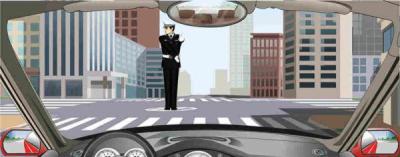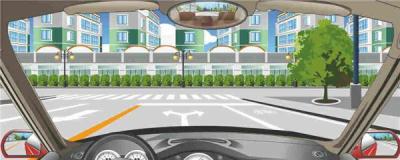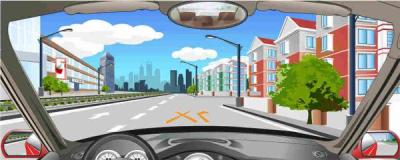1、In such circumstances, which one of the following statements is the safest measure for a motor vehicle driver to take?

A、Accelerate to overtake the vehicle in front as soon as possibl
B、Voluntarily reduce speed and refrain from overtaking
C、Sound the horn to warn the vehicle in front to yield
D、Turn on the headlamp to warn the oncoming vehicle to yield
Answer:B
2、The sign on the right indicates that the vehicle should yield to the oncoming traffic as approaching each other.

A、Right
B、Wrong
Answer:B
3、When there is a sudden braking failure on a downhill road, in which ones of the following ways can drivers reduce speed?
A、Driving onto the emergency lane and reduce speed and stop there
B、Rubbing the vehicle body against the rocks or trees on roadside
C、Pulling up the handbrake first
D、Immediately changing to a low gear
Answer:ABD
4、When extinguishing fire, the synthetic-made garments should not be taken off in order to protect the exposed skin from burning.
A、Right
B、Wrong
Answer:B
5、For a temporary stop on a foggy day, the driver should only turn on the fog lamp and the low-beam
A、Right
B、Wrong
Answer:B
6、Drivers may go straight and pass through when traffic police give these hand signals.

A、Right
B、Wrong
Answer:B
7、What should the driver do when the motor vehicle passes the level crossing?

A、Change to neutral gear and slide over
B、Stop, look and pass
C、Speed up, look and pass rapidly
D、Slow down, look and pass slowly
Answer:B
8、When encountering a road like this, motor vehicle drivers may make good use of neutral gear to coast.

A、Right
B、Wrong
Answer:B
9、The sign on the left indicates no U-turn at the intersection ahead.

A、Right
B、Wrong
Answer:A
10、When steering failure happens suddenly, if the road condition permits straight movement, drivers should not apply emergency braking.
A、Right
B、Wrong
Answer:A
11、It is not a bad habit for a driver to frequently change lanes.
A、Right
B、Wrong
Answer:B
12、The sign on the left warns of no passing on the right-hand road ahead.

A、Right
B、Wrong
Answer:B
13、Which one of following ways is the safest when driving a motor vehicle on this road?

A、Driving along the central line of the road
B、Driving along the right side of the road
C、Driving at the middle of the road
D、Driving along the left side of the road
Answer:B
14、The guide arrow on the road surface of this lane indicates that only left and right turns are permitted on the lanes ahead.

A、Right
B、Wrong
Answer:A
15、The road marker indicates that vehicles are only allowed to turn right at the intersection ahead.

A、Right
B、Wrong
Answer:B
16、When encountering a school bus which stops at the right roadside and students are embarking or disembarking, and there is only one motor vehicle lane in each direction, motor vehicle drivers behind the bus should stop and wait.
A、Right
B、Wrong
Answer:A
17、When driving on a damp and slippery road, drivers should avoid using the emergency brake to his/her best ability.
A、Right
B、Wrong
Answer:A
18、When the windscreen of a motor vehicle on the highway is cracked by flying rocks or debris which makes visibility poor, the driver should reduce speed gradually, turn on the hazardlamps, drive to a place where it will not obstruct the traffic flow and stop there.
A、Right
B、Wrong
Answer:A
19、When a motor vehicle passes over an inundated road the driver should change to a low gear and pass at a constant speed.
A、Right
B、Wrong
Answer:A
20、When braking, side skid or tail swing may occur if the rear wheels are blocked.
A、Right
B、Wrong
Answer:A